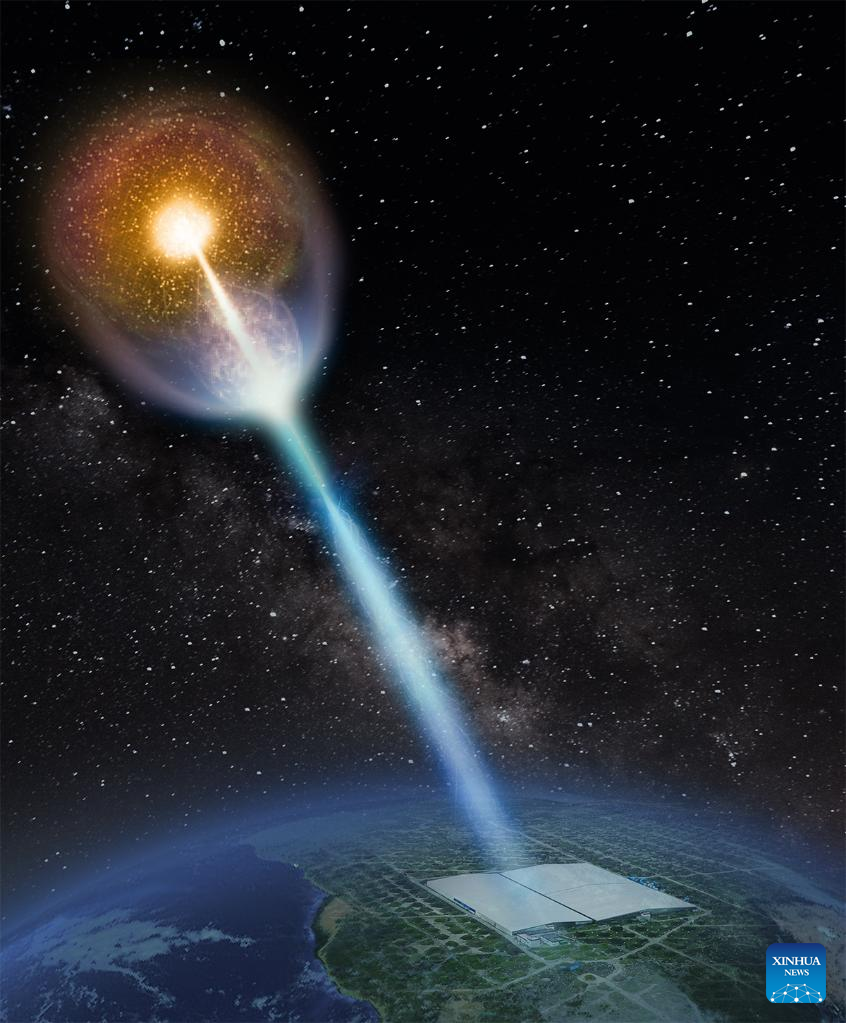
This artistic display image shows China's Large High Altitude Air Shower Observatory (LHAASO) recording the entire process of the brightest afterglow during the death of a massive star. A huge star in the depths of the universe ended its life in a brilliant explosion, ejecting a beam like a searchlight that happened to shine towards Earth. Its super high energy photons flew through the vast universe for about 2 billion years and coincidentally splashed on a newly built observatory in China. (The Institute of High Energy Physics of Chinese Academy of Sciences/Handout via Xinhua)
BEIJING, June 9 (Xinhua) -- A huge star in the depths of the universe ended its life in a brilliant explosion, ejecting a beam like a searchlight that happened to shine towards Earth. Its super high energy photons flew through the vast universe for about 2 billion years and coincidentally splashed on a newly built observatory in China.
This magnificent "cosmic firework" that occurred some 2 billion years ago was perfectly recorded, helping scientists to better understand the death of stars and the physical laws of the most violent explosions in the universe besides the Big Bang.
"Such an event only happens once in about 10,000 years, and how lucky we are to record it, which will be written into textbooks," said Cao Zhen, principal investigator of China's Large High Altitude Air Shower Observatory (LHAASO).
An international research team led by Cao peered into the extremely bright and rare gamma-ray burst named GRB 221009A, based on the observation of one of China's major scientific facilities, LHAASO, and the study was published online in the latest issue of the academic journal Science.
Through research, scientists reconstructed the glorious event. About 2 billion years ago, a massive star more than 20 times heavier than our Sun used up the fusion energy from its nuclear fuel, instantly collapsed, and triggered a massive explosion, thus unleashing a burst of cosmic firework known as a gamma-ray burst (GRB) that lasted hundreds of seconds.
This burst is the brightest ever recorded, with its brightness surpassing that of previous GRBs by several tens of times. Over 60,000 gamma-ray photons, generated from the collision between the fireball and interstellar matter, were finally collected by LHAASO.
"We discovered some phenomena never seen before," said Cao, also a professor at the Institute of High Energy Physics (IHEP) of the Chinese Academy of Sciences.
The flux of photons collected by LHAASO indicates that they came from the afterglow, the radiation following the main burst, and were produced when the ejected matter collides with the surrounding interstellar gas at speeds very close to the speed of light. LHAASO measured the complete process of the afterglow for the first time, said Cao.
LHAASO observed the complete high-energy light curve that other experiments have yet to reach, providing a perfect database for precise tests of the theoretical models on GRBs. Given the rarity of this event, it is expected that this observed result will remain one of the best for the next several decades or even centuries, Cao said.
At the beginning of the onset of the afterglow, LHAASO detected for the first time the extremely rapid enhancement of photon flux. This phenomenon exceeds the expectations of previous theoretical models and is expected to spark in-depth discussions within the scientific community regarding the mechanisms involved in GRBs, said Yao Zhiguo, a professor at IHEP.
"This observation also provided us with a clear picture of the structure of the jet generated by the GRB," said Wang Xiangyu, a professor at Nanjing University.
"The observer happens to be directly facing the brightest core of the jet, and it naturally explains why this gamma-ray burst is the brightest in history and why such an event is so rare," said Dai Zigao, a professor from the University of Science and Technology of China.
"As of now, there are still many unknowns in this burst event, and scientists are still analyzing the data in order to reveal more secrets," said Cao.
GRBs are the most violent explosive phenomena in the universe, with energy emitted within a few seconds equivalent to the total energy radiated by the Sun over 10 billion years, said Gao He, a professor at the Beijing Normal University.
Scientists expect to use GRBs to study the cosmic evolutionary history, the origin of heavy elements, and the validity of relativity, as well as other significant questions. However, a profound understanding of the physical origins of GRBs themselves is a prerequisite for addressing these issues, Gao said.
Located on a mountain about 4,410 meters above sea level in southwest China's Sichuan Province and covering an area of 1.36 square kilometers, LHAASO is used to conduct cosmic ray observation and research. Currently, 32 domestic and international universities and research institutes have become member institutions of the international collaboration of LHAASO, which includes approximately 280 collaborating scientists. ■



